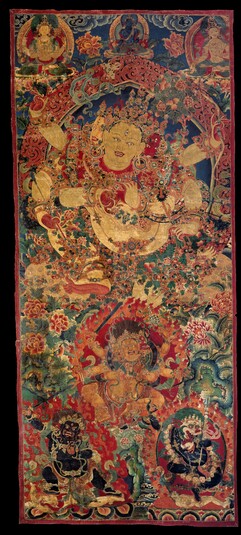
Item: Parnashavari (Buddhist Deity) - (three faces, six hands)
| Origin Location | Tibet |
|---|---|
| Date Range | 1800 - 1899 |
| Lineages | Gelug and Buddhist |
| Material | Ground Mineral Pigment on Cotton |
| Collection | Rubin Museum of Art |
Classification: Deity
Appearance: Semi-Peaceful
Gender: Female
Parnashavari and Janguli: Goddesses of Healing.
Parnashavari (Tibetan: ri tro ma, lo ma gyun ma. English: the Mountain Ascetic Wearing Leaves), the goddess who protects from contagious illness. (See the Parnashavari Main Page and Outline Page).
Tibetan: Lo ma gyun ma
Natural in colour (yellow), she has three faces and six hands. The main face is slightly peaceful and wrathful with three eyes and the hair tied with a snake in a topknot on the crown of the head. The red face on the left is in a desirous mood and the white face on the right is peaceful. The first pair of hands hold a gold vajra and a vajra lasso held to the heart. In the second pair is a vajra axe upraised in a manner of striking and a fan of fresh leaves and in the lower pair of hands is an arrow and bow. Adorned with gold and jewel ornaments, a circlet of fresh leaves around the neck and a long snake necklace she wears an upper silk scarf gray in colour. The lower body is covered with a thatched skirt of fresh leaves tied with a yellow silk ribbon. With the right knee pressing on the sun disc and lotus seat she sits in a kneeling posture. Flames and a dark blue nimbus surrounds the entire form.
At the top center is a blue buddha wearing silks and ornaments. At the left is the Four-armed All-seeing Lord (Avalokiteshvara) and White Tara is seated at the right side.
At the lower center is the wrathful goddess Janguli. [50] "Arya Janguli, yellow, with three faces. Having a hood of seven snake heads. [Each face] possessing three eyes and the faces [both] smiling and fierce. The six right hands hold, a vajra, sword and an arrow in a dancing manner. The left, a wrathful [gesture] together with a lasso, a blue poisonous flower and a bow. Adorned with flowers and snakes. Standing in a dancing manner." (Konchog Lhundrub, 1497-1557).
At the bottom left is Achala according to the Atisha Tradition. At the bottom right side is the wrathful goddess Simhamukha.
The background portrays a lush green landscape rich with various offerings of wish-fulfilling jewels and auspicious objects arranged as offerings petitioning the special healing favours of the deities.
Parnashavari belongs to the Kriya class of tantra and is employed in the eradication of contagious disease. Various lineages of practice are found in both the Nyingma and Sarma schools of Tantric Buddhism.
Associated with the mysterious Shavari tribe of ancient India, the Forest Goddess with three faces and six hands wears a skirt and garland of thatched green leaves. She has always been associated with jungle tribes and the practice of healing. Her specialty is contagious disease. In the Himalayas and Tibet it is common place when a large group of people congregate to receive extended religious teachings to first give the initiation and blessing for the Forest Goddess in order to stave off sickness.
The Forest Goddess is an example of an Indian folk deity absorbed into Tantric Buddhism. She is a popular practice and has numerous forms with varying emphasis. From the point of view of Buddhist Esoteric meditation, the Forest Goddess is an emanation of the Buddha, and her special characteristic or metaphor is that of sickness and healing.
This type of painting with unusual dimensions is generally intended as a mural. Painted on cloth it is then glued to a temple wall. The gold paint, leaf or gold powder, is intended as a lavish offering by the donor to increase the merit accrued by having sacred objects created, the more gold the more merit. Three other female deities are represented in this painting, White Tara at the top right, a fearsome goddess at the lower center and the Lion-faced Goddess at the bottom right.
Jeff Watt 5-2005 [updated 1-2021]
Exhibition: Female Buddhas at RMA
Thematic Sets
Buddhist Deity: Parnashavari & Janguli Comparison
Buddhist Deity: Parnashavari Main Page
Buddhist Deity: Parnashavari (Yellow, Three Faces)
Subject: Deity Colours - Yellow Main Page (Increasing Activities)
Buddhist Deity: Parnashavari Iconography
Buddhist Deity: Parnashavari (Painting Masterworks)
Collection: Christie's, Painting (September, 2003; NY)
Collection of Rubin Museum of Art (RMA): Main Page

